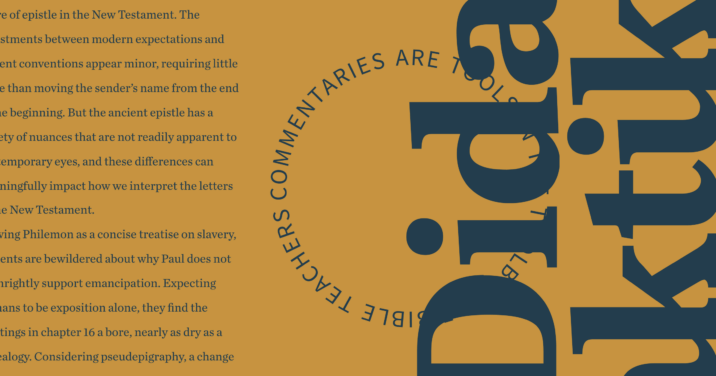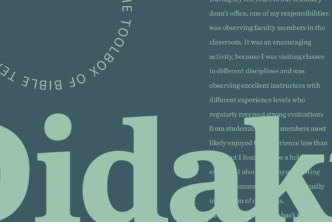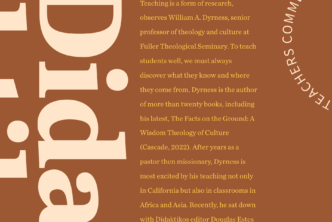Inviting Students to Confront Their Misrepresentations About Jesus
Michael Kibbe | Great Northern University
“The Gospel of Mark can be summed up in two words: Rome wins.” I speak these words about sixty minutes into my first hermeneutics session of every semester. It’s a sophomore-level general education course at an evangelical liberal arts university, and since the students have already had OT and NT survey on top of whatever church/Christian education background they possess, the biblical literacy rate is reasonably high. But whatever perspective they’ve come in with about the story of Jesus, “Rome wins” probably isn’t it.1
We begin the session by discussing the opening lines of Mark’s Gospel—particularly what Mark has in mind by calling his account of Jesus’ life the “gospel” (hint: it’s got something to do with Isaiah and something to do with Caesar). We then break into small groups for a while. Each group examines a different demonstration of Jesus’ authority in Mark, and then we discuss those demonstrations as a whole class. By the time we get to the cursing of the temple and the fig tree in Mark 11, it’s fairly obvious that Jesus is clearing a path toward a final showdown with the Roman authorities in Jerusalem. He has already conquered demons, diseases, religious teachers, and the weather. One hardly expects a confrontation with Rome to go any differently—and yet, at the story’s conclusion, Jesus is broken and dead, on humiliating display with the same message so many others have proclaimed by their defeat: don’t mess with Rome.
“Let’s take a break. See you in ten minutes.”
A confusing portrayal
While I’ve gotten better at the various components of this session, both before and after the break, I’ve noticed over the years an increasing temptation to resolve the tension I’ve created in that first hour. To do so, however, would undermine the very thing I’m trying to do: tell the story of Jesus on Mark’s own terms. I don’t just mean telling the story of Jesus using Mark’s particular set of data points (though the absence of the final data point, the resurrection of Jesus, is a tremendously important piece of the Markan puzzle). I want to teach Mark the way Mark teaches—or, to put it a bit differently, I want to teach Jesus the way Mark teaches Jesus, which is in fact the way (according to Mark) that Jesus himself taught.2
“What do you do when you come to the end of a story and discover that the ending is not at all what you expected?” This is how we begin the second portion of the class. You might dismiss it as poor storytelling, which is what some have done with Mark. Or, if you’re intrigued and/or confused enough to take the time to do so, you might go back and read/hear/watch the story again. And if you did that with Mark, you’d find that things are actually much more confusing than you had realized. First, Jesus doesn’t want anyone to know what he’s doing (Mark 1:34, 43; 3:12; 5:43; 7:36; 8:30). Second, Jesus doesn’t want anyone to understand what he’s saying (Mark 4:10–12). Third, while Jesus has given the inside scoop to a select few, they never catch on, because—this is important—they don’t ask Jesus to explain himself when he says something they don’t understand. (No, really—grab a red-letter Bible and see what comes right before the times in Mark’s account where Jesus speaks for more than a couple of verses in a row. Then look at what happens just prior to other moments where you’d like that to have happened, but it didn’t.)
Despite Jesus’ repeated insistence that going to Jerusalem to die is exactly what he intends to happen—it’s the one thing he says “clearly” (Mark 8:32)—no one sees it coming. The story ends with a couple of women running away in fear and telling no one that some random guy at the tomb says Jesus isn’t there anymore.
The picture comes together
So now students have been through the story twice, and their confusion has only increased the second time around. What to do next?
At this point the temptation begins to grow in me to lay out the clear path—to reassure them that the evil empire does not, in fact, win; that of course the gospel according to Isaiah triumphs over the gospel according to Rome. But speeding ahead to the happy ending is precisely not what Mark does. Mark leaves you hanging. Mark wants you to be confused. Just like, as one of my students remarked at the end of one of these sessions, Jesus wanted his followers to be confused. So even though I’ve gotten better at making sure that everyone in the room gets what this has been all about, that’s not what Mark wants me to do. To do pedagogy Mark’s way, in fact, is to make it harder on all of them—so that those who are willing to step out and admit their ignorance, to recognize that the story of Jesus does not go the way they thought it did, can then take real steps toward understanding and following Jesus.
Just to be clear: this isn’t a power exercise wherein you withhold knowledge from students to make sure they know you’re in charge, or a manipulative carrot to bend them to your will. Nor is it a screening project to distinguish the good students in your class from those you can basically ignore the rest of the semester. Mark’s intent, Jesus’ intent, is not to lord it over the blind but to give them sight—if only the blind are willing to acknowledge their blindness. But you can’t just say that to students. They have to experience it like the disciples experienced it. They have to walk blindly for a while, stumble a few times, and recognize they’ve been wrong about Jesus all along. Then—and only then, according to Mark—can they come face to face with the resurrected Jesus and see how the whole picture fits together.
It might still seem arrogant to put yourself in Mark’s shoes, as though your position vis-à-vis Jesus is to your students what Mark’s was to his audience. But consider the source: if, as most believe, the apostle Peter is the source behind Mark’s material, consider the self-portrait of the good news according to Peter. “Clueless” is one of the kinder words we might use to describe him. He’s the poster child for not understanding Jesus. That matters substantially, because Peter’s self-effacement makes sense only if he did come to understand, in retrospect, how exactly a crucifixion at the hands of Rome could be a triumph over Rome. But it also matters pedagogically, because Peter is anything but the hero.
If you tell the story of Jesus according to Mark and set yourself up as the brilliant professor whose insights will ultimately rescue students from the dark tyranny of ignorance, you have not actually taught Mark’s way. You must be the punchline of your joke, not the savior of your story. If ever your own experience is center stage, it must be your experience of failure, of foolishness, of blindness. And when the light finally dawns for one student or another, they’ll barely remember that you were there when it happened. And if some of them even exalt their own knowledge over the ignorance of their professor—as we all too often do to Peter!—so be it.
Let our students be inspired to relentlessly pursue deeper understanding, as many must have been who couldn’t understand why the disciples would advertise their own failures while exalting a crucified king on the streets of the Roman polis.
Michael Kibbe’s primary research interest is the book of Hebrews, and he is currently writing on the ascension of Jesus in Hebrews 1–2. He also is working on a project dealing with the transfiguration of Jesus in the history of biblical interpretation and writing a book on theological pedagogy.
This article was first published in Didaktikos: Journal of Theological Education. Subscriptions are free to faculty members; sign up here.

]]>
-
Among biblical scholars, of course, little of this session would ruffle any feathers (though there are disagreements regarding the details). Mark looks at Jesus through Isaiah-colored lenses; Mark’s description of Jesus’ arrival as the “beginning of the good news” bears noncoincidental resemblance to the Priene Inscription; Mark’s Gospel originally ended at 16:8; Mark’s primary source was the apostle Peter; the Markan Jesus is obsessed with secrecy (up until Peter’s confession, at least); and the Markan Jesus is impossible to understand apart from the one event that Mark does not narrate—the resurrection. For those less familiar with these conversations, I recommend (as a starting point) Rikki E. Watts, Isaiah’s New Exodus in Mark, BSL (Grand Rapids: Baker Academic, 2001); Peter G. Bolt, The Cross from a Distance: Atonement in Mark’s Gospel, NSBT 18 (Downers Grove, IL: IVP Academic, 2004); and Craig A. Evans, “The Beginning of the Good News and the Fulfillment of Scripture in the Gospel of Mark,” in Hearing the Old Testament in the New Testament, ed. Stanley E. Porter (Grand Rapids: Eerdmans, 2006), 83–103.
- It might seem dangerous to ignore the historical and cultural gap between us and Mark’s audience and simply assume that what worked for Mark will work for us. There are two different questions at stake here: (1) What elements of Markan pedagogy can actually work in a very different context (e.g., a twenty-first-century confessional undergraduate classroom in the northwestern United States)? and (2) Does the authority of the biblical authors extend beyond the “what” (their theological content) to the “how” (their theological method)? I am convinced that the answer to the latter question is “yes!” but it would take more space than I have here to defend my position. To the former question, though, two points are in order. First, I am not suggesting we imitate Mark’s form—that we move to Rome, write in Greek, tell only the stories he tells and in the order he tells them, and so on. The cultural distance, not to mention the existence of three other Gospels, would undermine such a requirement. Second, what I am suggesting is that Mark has given us a powerful way to raise students’ awareness of their lack of understanding as well as a compelling invitation to overcome that shortcoming and grow in their relationship with Jesus. Imitation of Mark at this level works because it appeals to the fundamental human reality that we are not compelled to learn until we recognize our ignorance, and because it emerges from the fundamental kingdom reality that in testimony of our weakness the power of God is most fully revealed.





